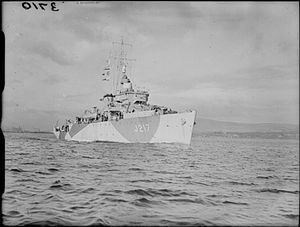Name HMS Loyalty Laid down 14 April 1941 Commissioned 22 April 1943 Launched 9 December 1942 Weight 863.6 tons Builder Harland and Wolff | Yard number 1142 Completed 22 April 1943 Construction started 14 April 1941 Length 69 m Displacement 771,100 kg | |
 | ||
Renamed Launched as HMS RattlerRenamed HMS Loyalty in June 1943 | ||
HMS Loyalty was an Algerine-class minesweeper of the Royal Navy. She served during the Second World War. Commissioned in 1943, Loyalty saw action off the coast of Normandy during the Allied assault there in 1944. While performing duties off the coast, the ship was torpedoed by a German submarine and sank.
Contents
Service
Loyalty was laid down as HMS Rattler on 14 April 1941 at Harland and Wolff, Belfast, and launched on 9 December 1942. She was commissioned on 22 April 1943, and renamed HMS Loyalty in June 1943. She was adopted by the community of Ripley, North Yorkshire after a Warship Week national savings campaign in March 1942.
After commissioning she was assigned to the 18th Minesweeping Flotilla, joining them in June 1943. She and the other ships of the flotilla carried out sweeping operations in Lyme Bay and the English Channel. She and other ships of the flotilla were transferred to Harwich in August to sweep areas of the North Sea, but was soon transferred to the 9th Flotilla, at Dover. On 25 August Loyalty was part of Operation Starkey, an attempt to attract German aircraft to unusual minesweeping operations near the French coast. The ships of the flotilla came under fire from shore batteries, and Hydra was damaged. They returned to Dover, but were mistakenly fired on by British shore batteries, causing further damage. Loyalty did not return to minesweeping duties until October.
In November Loyalty transferred to Scapa Flow to join the 15th Minesweeping Flotilla with the Home Fleet. She transferred again in December to the Orkney and Shetland Command, operating out of Seidisfjord on anti-submarine patrols and local convoy escort duties. She remained here until being nominated to return to the UK in March 1944 and in April underwent a refit at Portsmouth, after which she was assigned to Force G to give minesweeping support to the Allied landings in Normandy. Loyalty spent May carrying out exercises and rehearsals, and also escorted sister ship Stormcloud into Portsmouth after she had been damaged by a mine. Loyalty then took part in the assault operations of 6 June, clearing Channel 6, and then remaining deployed off Gold Beach to cover operations. She remained off Normandy after the landings and throughout July, carrying out sweeps of the anchorages.
Sinking
Loyalty was still off Normandy in August. She was returning to Portsmouth with the minesweepers Ready, Hound, Hydra and Rattlesnake when the sweep wires parted. Loyalty and the minesweeping trawler Doon were dispatched to recover the sweep. As they were doing this Loyalty was attacked and sunk by the German U-boat U-480 commanded by Hans-Joachim Förster at position 50°09′N 00°41′W in the English Channel. She capsized in less than seven minutes, with the loss of her captain and 18 ratings. There were 30 survivors. Loyalty was replaced in the flotilla by sister ship Tanganyika. The wrecksite is designated as a protected place under the Protection of Military Remains Act 1986.
